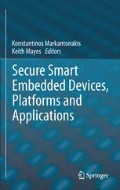The online version of the original book can be found under DOI 10.1007/978-1-4614-7915-4
You have full access to this open access chapter, Download chapter PDF
Keywords
- Vehicle License Plate Recognition System
- Smart Card Centre
- Applied Electronic Commerce Research
- Senior Managerial Work
- Licensing Executives Society
These keywords were added by machine and not by the authors. This process is experimental and the keywords may be updated as the learning algorithm improves.
Errata to: K. Markantonakis and K. Mayes (eds.), Secure Smart Embedded Devices, Platforms and Applications, DOI 10.1007/978-1-4614-7915-4
Biography for Dr. Keith Mayes in book front matter should read as below:
-
Keith Mayes B.Sc. Ph.D. (Bath) CEng FIET received his BSc (Hons) in Electronic Engineering in 1983 from the University of Bath and his PhD degree in Digital Image Processing in 1987. He is an active researcher/author with over a 100 publications in conferences, books and journals. His interests include the design of secure protocols, mobile/fixed communications systems and security tokens/NFC/RFID as well as associated attacks/countermeasures. During his first degree he was employed by Pye TVT (Philips) which designed and produced TV broadcast and studio equipment. His PhD was sponsored by Honeywell Aerospace and Defence and on completion he accepted their offer of a job. In 1988 he started work for Racal Research where he worked on a wide range of research and advanced development products and was accepted as a Chartered Engineer. In 1995 he joined Racal Messenger to continue work on a Vehicle Licence plate recognition system (Talon) and an early packet radio system (Widanet/Paknet). In 1996 Keith joined Vodafone as a Senior Manager working within the Communication Security and Advanced Development group. Early work concerned advanced radio relaying systems and involved participation in international standardisation (ETSI SMG2). Later he led the Maths and Modelling team and eventually took charge of the Fraud and Security group. During this time he was training in intellectual property and licensing, culminating in membership of the Licensing Executives Society and the added responsibility for patent issues in Vodafone UK. In 2000, following some work on m-commerce and an increasing interest in Smart Cards he joined the Vodafone International organisation as the Vodafone Global SIM Card Manager, responsible for SIM card harmonisation and strategy for the Vodafone Group. In 2002, Keith left Vodafone to set up Crisp Telecom (www.crisptele.com) and in November 2002 he was also appointed as the Director of the Smart Card Centre (www.scc.rhul.ac.uk) at Royal Holloway University of London, reporting to Professor Fred Piper in the world renowned Information Security Group (www.isg.rhul.ac.uk). Keith is a Fellow of the Institution of Engineering and Technology, a Founder Associate Member of the Institute of Information Security Professionals and a member of the editorial board of the Journal of Theoretical and Applied Electronic Commerce Research (JTAER). He has also had director experience within a London stock market listed company and a subsidiary of an American communications company. Recent high profile activity included leading the expert team that carried out counter-expertise work on the Ov-Chipkaart for the Dutch transport ministry, following published attacks on the MIFARE Classic chip card; and acting as General Chair for ESORICS 2013.
In Chap. 10, following corrections need to be corrected:
-
Page 235, Section 10.3.2, first paragraph after bullet points, Line 3 should refer Fig. 10.3.
-
Page 249, Section 10.6.2, Paragraph 1, Line 6, “specialisthardware”, typo - still need to add a space between the words, i.e. it should read as ‘specialist hardware’.
-
Page 255, Section 10.7.1 , Paragraph 2, Line 7, “RTM [42]”, non-existent reference—just delete [42] after RTM.
-
Page 256, Section 10.7.2, Paragraph 2, Line 2, “resistance”, typo - still need to change resistance to resistant.
In Chap. 12, following corrections need to be corrected:
-
In Section 12.3.3, sentence “They offer a number of pre-implemented cryptographic services such as DES/3DES, AES, hash functions, long number arithmetic for public key operations, RSA, ECC, secure generation of random numbers,.” should not have a comma before the period.
Author information
Authors and Affiliations
Corresponding author
Editor information
Editors and Affiliations
Rights and permissions
Copyright information
© 2014 Springer Science+Business Media New York
About this chapter
Cite this chapter
Markantonakis, K., Mayes, K. (2014). Errata to: Secure Smart Embedded Devices, Platforms and Applications. In: Markantonakis, K., Mayes, K. (eds) Secure Smart Embedded Devices, Platforms and Applications. Springer, New York, NY. https://doi.org/10.1007/978-1-4614-7915-4_25
Download citation
DOI: https://doi.org/10.1007/978-1-4614-7915-4_25
Publisher Name: Springer, New York, NY
Print ISBN: 978-1-4614-7914-7
Online ISBN: 978-1-4614-7915-4
eBook Packages: Computer ScienceComputer Science (R0)

